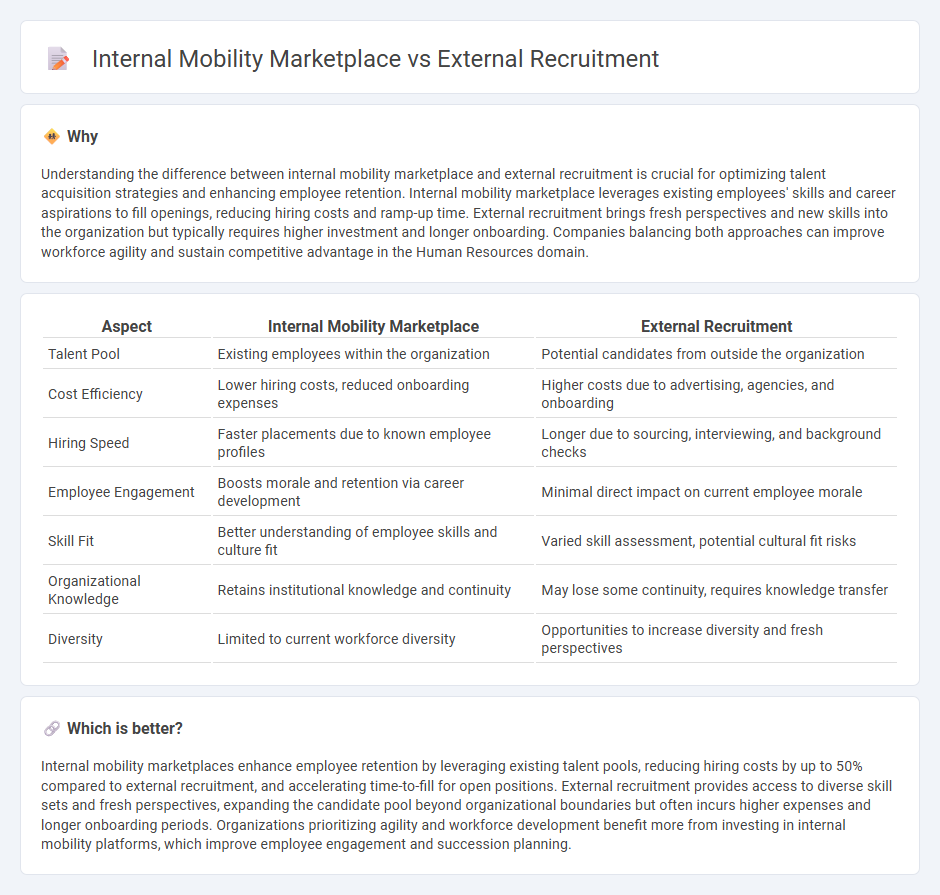
Internal mobility marketplaces enable organizations to leverage existing employee talent by matching skills with new roles, enhancing retention and reducing hiring costs. External recruitment expands the candidate pool, bringing fresh perspectives but often involves higher expenses and longer onboarding processes. Discover how balancing internal mobility and external recruitment strategies can optimize workforce agility and business outcomes.
Why it is important
Understanding the difference between internal mobility marketplace and external recruitment is crucial for optimizing talent acquisition strategies and enhancing employee retention. Internal mobility marketplace leverages existing employees' skills and career aspirations to fill openings, reducing hiring costs and ramp-up time. External recruitment brings fresh perspectives and new skills into the organization but typically requires higher investment and longer onboarding. Companies balancing both approaches can improve workforce agility and sustain competitive advantage in the Human Resources domain.
Comparison Table
| Aspect | Internal Mobility Marketplace | External Recruitment |
|---|---|---|
| Talent Pool | Existing employees within the organization | Potential candidates from outside the organization |
| Cost Efficiency | Lower hiring costs, reduced onboarding expenses | Higher costs due to advertising, agencies, and onboarding |
| Hiring Speed | Faster placements due to known employee profiles | Longer due to sourcing, interviewing, and background checks |
| Employee Engagement | Boosts morale and retention via career development | Minimal direct impact on current employee morale |
| Skill Fit | Better understanding of employee skills and culture fit | Varied skill assessment, potential cultural fit risks |
| Organizational Knowledge | Retains institutional knowledge and continuity | May lose some continuity, requires knowledge transfer |
| Diversity | Limited to current workforce diversity | Opportunities to increase diversity and fresh perspectives |
Which is better?
Internal mobility marketplaces enhance employee retention by leveraging existing talent pools, reducing hiring costs by up to 50% compared to external recruitment, and accelerating time-to-fill for open positions. External recruitment provides access to diverse skill sets and fresh perspectives, expanding the candidate pool beyond organizational boundaries but often incurs higher expenses and longer onboarding periods. Organizations prioritizing agility and workforce development benefit more from investing in internal mobility platforms, which improve employee engagement and succession planning.
Connection
Internal mobility marketplaces enhance employee retention by identifying skill gaps and promoting talent within the organization, which reduces dependency on external recruitment. External recruitment complements this by bringing fresh perspectives and specialized skills that internal candidates may lack, ensuring a steady inflow of diverse expertise. Together, they create a dynamic talent acquisition strategy that balances workforce agility and organizational growth.
Key Terms
Talent Acquisition
External recruitment expands the talent pool by attracting candidates with diverse skills and fresh perspectives from outside the organization, often accelerating hiring timelines for specialized roles. Internal mobility marketplaces leverage existing employee data to match skills with open positions, boosting retention, reducing hiring costs, and promoting career development within the company. Explore how integrating both strategies can optimize Talent Acquisition for sustained organizational growth.
Succession Planning
External recruitment sources expand the talent pool by attracting diverse skill sets and fresh perspectives, which can fill critical succession planning gaps rapidly. Internal mobility marketplaces leverage existing employee skills and career aspirations, fostering engagement and retaining institutional knowledge critical for leadership continuity. Explore how integrating both approaches can optimize succession planning and ensure a resilient talent pipeline.
Employee Retention
External recruitment often introduces fresh skills and diverse perspectives but can challenge employee retention due to cultural fit uncertainties and longer adjustment periods. Internal mobility marketplaces enhance retention by leveraging existing employee talents, boosting morale, and fostering career development within the organization. Discover how optimizing talent pipelines through internal mobility can significantly improve employee engagement and retention rates.
Source and External Links
External recruitment: Best practices for your business - Personio - External recruitment involves filling a job vacancy with candidates from outside the organization using methods like online job boards, social media, recruitment agencies, job fairs, and employee referral schemes.
What are the 5 external recruitment methods? - HeroHunt.ai - The five most common external recruitment methods are advertising, employee referrals, job fairs, search firms, and social media, each offering unique benefits for reaching diverse candidate pools.
Guide: External recruitment advantages and disadvantages - Indeed - External recruitment opens vacancies to a broader pool than internal recruitment, allowing companies to evaluate internal staff against external candidates and bring fresh perspectives, though it can be more costly.
 dowidth.com
dowidth.com